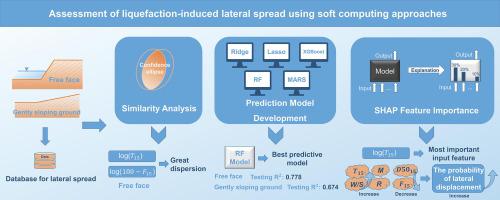Gondwana Research ( IF 6.1 ) Pub Date : 2022-08-17 , DOI: 10.1016/j.gr.2022.08.006 Zhixiong Chen , Yuhui Chen , Yanmei Zhang , Xingguo Liu , Peng Xiao , Pijush Samui

|
Lateral spread is a common ground deformation induced by soil liquefaction, which has caused extensive damage to buildings and lifelines in past earthquakes. At present, several empirical methods for assessing lateral displacement have been proposed. Due to the complexity of the problem, it is difficult for traditional methods to predict the lateral spread displacement with high accuracy. In this study, a new database of 522 lateral spreading case histories was established based on the databases developed by Youd et al., Chu et al., and NGL (Next Generation Liquefaction). The confidence ellipse was used to evaluate the similarity between parameters of liquefiable soil layers for two site conditions (free face and gently sloping ground). Then, based on the new database, predictive models for assessing liquefaction-induced lateral displacement were developed by different soft computing approaches including Ridge Regression, Lasso & Lasso CV, Random Forest Regression (RF), eXtreme Gradient Boost (XGBoost), and Multivariate Adaptive Regression Splines (MARS). The MARS model showed good predictive performance (the R2 values were 0.583 and 0.555 on testing set, respectively) and can generate explicit expressions. The results of SHAP investigation showed that log(T15) is the most important feature variable in RF model, where T15 is the thickness of liquefiable soil layer. Further analysis showed that thicker liquefiable soil layers, smaller epicentral distances, larger magnitudes, and unfavorable topographical conditions will increase the possibility of lateral displacement, while larger grain sizes and more fines contents will reduce the probability of lateral displacement.
中文翻译:

使用软计算方法评估液化引起的横向扩散
横向蔓延是土壤液化引起的常见地面变形,在过去的地震中对建筑物和生命线造成了广泛的破坏。目前,已经提出了几种评估横向位移的经验方法。由于问题的复杂性,传统方法难以高精度地预测横向扩展位移。在本研究中,基于 Youd 等人、Chu 等人和 NGL(下一代液化)开发的数据库,建立了一个包含 522 例横向传播病例历史的新数据库。置信椭圆用于评估两种场地条件(自由面和缓坡地面)的液化土层参数之间的相似性。然后,基于新的数据库,用于评估液化引起的横向位移的预测模型是通过不同的软计算方法开发的,包括 Ridge 回归、Lasso 和 Lasso CV、随机森林回归 (RF)、eXtreme Gradient Boost (XGBoost) 和多元自适应回归样条 (MARS)。MARS 模型显示出良好的预测性能(R 2值在测试集上分别为 0.583 和 0.555)并且可以生成显式表达式。SHAP调查结果表明log( T 15 )是RF模型中最重要的特征变量,其中T 15是液化土层的厚度。进一步分析表明,较厚的液化土层、较小的震中距、较大的震级和不利的地形条件会增加横向位移的可能性,而较大的粒径和更多的细粒含量会降低横向位移的可能性。


























 京公网安备 11010802027423号
京公网安备 11010802027423号